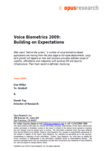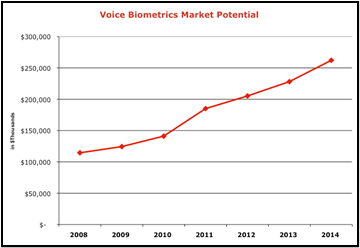Webcast On-Demand Opus Research and Nuance Communications provide insight into the current state of the voice biometrics market now that the debate is well-beyond “whether the technology works.” In recent months, high-profile financial institutions, government agencies, health insurance underwriters, and… Read More ›
speaker verification
Voice Biometrics 2009: Building on Expectations

Featured Research
After years “behind the curtain,” a number of voice biometrics-based applications are moving from the pilot stage to full-scale deployments. Long-term growth will depend on how well solutions providers address issues of usability, affordability and integration with existing IVR and security infrastructure. Their track record is definitely improving.
Featured Research Reports are available to registered users only.
For more information on becoming an Opus Research client, please contact Pete Headrick (pheadrick@cgy.bcc.myftpupload.com).
The Message of Voice Biometrics: “Your Identity is Important to Us”
One of the banes of phone-based commerce is the phrase, “Your call is important to us.” It tends to be the last thing an inbound customer hears from an IVR system before being put on interminable hold. It would be much more reassuring – and accurate – for an IVR to say that “Your identity is very important to us” and then, rather than indiscriminately placing each call on hold, to treat each caller according to his or her expressed preferences, status, or other known attributes.
National Australia Bank Launches Customer-Facing Voice Biometric Service

Australia continues to be a hotbed for the latest in voice biometrics announcements. In another widely rumored deployment, National Australia Bank (NAB) has officially launched a voice verification service, making it available to the company’s 3.3 million personal banking customers.
Aimed at “delivering enhanced customer experience and security,” the public deployment comes after NAB ran a successful internal pilot involving 2,000 branch staff in May. The voice biometrics-based service is part of a multi-million dollar effort to upgrade a range of new security functions available to NAB personal banking customers.
According to a company statement, “With identity theft related fraud increasingly moving to the phone channel, the use of voice biometrics enables the effective identification, authentication and verification of customers, offering an extra layer of protection,” said Warren Shaw, executive general manager with NAB Personal Banking.
Successful authentication pilot programs have longed been rumored for financial services organizations, but NAB’s official launch marks the first bank – both in Australia and globally – to go public with a large-scale, customer-facing service. More to come…
Centrelink Unveils Voice Authentication System

In a widely anticipated deployment, Australian social services agency Centrelink has officially launched a biometric speaker verification system used to authenticate customer access to welfare services. The $2 million system has been in development for more than two years, including a pilot program for students and families, and is now available to up to 60,000 Centrelink customers.
Because customers were having trouble remembering passwords for phone access, speaker verification was implemented as “the only thing that might work beyond a PIN,” said Ross Summerfield, Project Manager with Centrelink. Additionally, the voice self-service system frees up Centrelink to handle more complex cases and hopes to improve staff efficiency in handling some 28 million calls per year.
While the opt-in system is initially targeting “customers without complex lodging requirements and who may need to routinely update simple information,” Summerfield says they have no intention of rolling it out to all Centrelink customers. To recruit the initial customers, employees have been actively calling and inviting prospective users.
Summerfield says enrollment takes about five minutes, with a customer repeating an access number three times, their name twice and counting “1 to 9” a minimum of two times. Once authenticated, the user has access to all telephone self-service offerings.
Telecommunications provider Telstra has managed the service delivery, while KAZ provided project management for connecting the system components to Centrelink’s security services. As well, KAZ built dual, text-independent speaker verification engines, with Nuance providing an additional text-dependent engine.
Though the program is only officially available to Centrelink customers this week, Summerfield said measurements during the 2007-2008 pilot showed that 90% of callers would prefer to use speaker verification over a PIN, with 95% finding the system friendly and easy to use and 98% saying they would use it the next time they accessed Centrelink.
Fundamentals of Speaker Verification and Biometric-Based Authentication
Featured Research Classifying speech recognition and Speaker Verification as technical cousins has done nothing to further the market development for either technology. Speaker Verification is more than an enhancement to ‘Voice Self-Service’ applications. It is an extension of an organization’s… Read More ›

